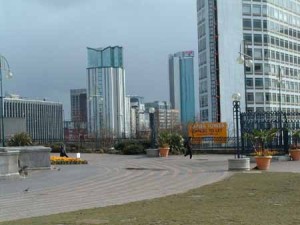Alan Clawley on the limited value of Environment Impact Assessments on town planning.
 In these times of environmental awareness planning applications have to be accompanied by an Environment Impact Assessment (EIA).
In these times of environmental awareness planning applications have to be accompanied by an Environment Impact Assessment (EIA).
The EIA that will accompany Argent’s application for Paradise Circus includes lengthy statements of the impact that the proposed development would have on the local wildlife, especially protected species such as Black Redstarts and bats.
Now it would be very surprising to discover much wildlife other than feral pigeons and rats living in Paradise Circus, but nevertheless the planning bureaucrats demand that a suitably qualified naturalist be hired by the applicant to write an EIA to confirm what we already know – that the Central Library is not a good place for roosting bats and that the proposed office buildings will be even worse. And, as there are no nesting Redstarts on the traffic-girt island of Paradise Circus they will be unaffected by the din and dust of demolition and rebuilding over the coming 15 years. The impact of the redevelopment on wildlife and biodiversity is therefore of marginal local importance.
So, all is well and the planners can approve the application with a clear conscience. Yet the underlying aim of this regulation is baffling. Its outcome is to make a bad environment for wildlife even worse. It is based on the concept that nature can only be conserved if there is some to start with and even then it is acceptable to mitigate impacts by moving it somewhere else. The long-term result will be the sanitising and denaturing of towns and cities and a tendency to turn the natural environment into a series of wildlife reserves. A Peregrine Falcon nesting on the roof of the empty NatWest tower in Colmore Row will not stop developers getting permission to demolish it. The bird can go to another empty office block. Pigeons on the other hand are treated as a pest and the only worry the planners have about them is how to stop them roosting on the handy ledges that replicate their natural cliff-like habitat. So when the architects of the new library were warned that the rings on the new library would be a pigeons’ paradise, they responded by promising to install electronic bird-scarers.
 A serious assessment of the environmental impact of the redevelopment of Paradise Circus must consider more than its marginal impact on wildlife. It must examine the wider impact of the demolition of the existing buildings and structures, the construction of the new buildings, structures and utilities, the construction of the Library of Birmingham and the refurbishment and adaptation of Lousia Ryland House for the Conservatoire. It must measure the CO2 already embodied in the existing buildings and structures, the CO2 emissions from the new construction process, and the changes in CO2 emissions resulting from the use of all of these buildings and structures. The energy-efficiency and carbon footprints of the new buildings should be compared with that of the existing buildings retro-fitted to the same standard
A serious assessment of the environmental impact of the redevelopment of Paradise Circus must consider more than its marginal impact on wildlife. It must examine the wider impact of the demolition of the existing buildings and structures, the construction of the new buildings, structures and utilities, the construction of the Library of Birmingham and the refurbishment and adaptation of Lousia Ryland House for the Conservatoire. It must measure the CO2 already embodied in the existing buildings and structures, the CO2 emissions from the new construction process, and the changes in CO2 emissions resulting from the use of all of these buildings and structures. The energy-efficiency and carbon footprints of the new buildings should be compared with that of the existing buildings retro-fitted to the same standard
Worthy though EIAs are, they can never enable a planning committee to reject an application on environmental grounds alone because it is given no objective way of measuring the various impacts against a statutory national or global standard. Besides it’s all too easy for the applicant with a clever consultant to throw in a few measures to mitigate any impacts that worry a committee.
Requiring new developments from now on to be ‘sustainable’ sounds good but planning lawyers on both sides are set to make a good living arguing between themselves about what that slippery word really means.


